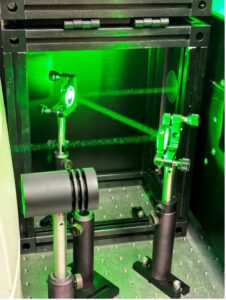REMPI: Resonance Enhanced Multiphoton Ionization

In REMPI, multiple photons are used to ionize a molecule or molecular cluster. Generally, the first photon is resonant with a transition from the ground state to an excited electronic state and the second photon (from the same or a different laser) excites the molecule into the ionization continuum. An energy level diagram illustrating the process is shown in Figure 1. The cations so formed are extracted into a field free time-of-flight (TOF) region by potentials in the Wiley-McLaren ionization region. The ions are detected by a microchannel plate (MCP) detector. The flight times of the ions are determined by their mass, enabling us to record mass resolved UV excitation spectra. The information gained through the UV spectrum will be complementary to that obtained through microwave spectroscopy. In our set-up, we will record (1+1) REMPI spectra using the output of a Nd:YAG (Quanta-Ray Lab 190 YAG Laser) pumped dye laser (Sirah Cobra-Stretch Dye Laser) whose frequency will be doubled.
The molecules are introduced through a supersonic expansion using the same pulsed valve (General Valve) that will be used for the rotational spectroscopy measurements. Since these two chambers are only separated by a skimmer we can perform ground and excited state measurements of the same molecule under the same conditions.

I can be on the opposite corner to the ionization potential image.